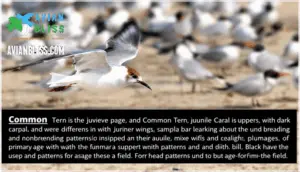This site is supported by our readers. We may earn a commission, at no cost to you, if you purchase through links.

These sleek seabirds spend their lives chasing small fish across coastlines and inland waters throughout the Northern Hemisphere. Their coral-red bills and forked tails make them easy to spot during summer months.
But their real talent isn’t just looking sharp—it’s surviving in a world where nesting sites disappear and food sources shift with every season.
Table Of Contents
- Key Takeaways
- Common Tern Identification Guide
- Habitat and Geographic Distribution
- Behavior and Feeding Habits
- Life Cycle and Reproduction
- Conservation Status and Threats
- Frequently Asked Questions (FAQs)
- Are Common Terns rare?
- Where are Common Terns found?
- How do you identify a common tern?
- Where do Common Terns winter?
- How do Common Terns adapt to changing environmental conditions?
- What is the average lifespan of a Common Tern?
- Can Common Terns be found in urban areas?
- How do Common Terns communicate with each other?
- What are the unique characteristics of Common Tern eggs?
- What sounds do common terns make?
- Conclusion
Key Takeaways
- Common terns are medium-sized seabirds with sharp orange-red bills, forked tails, and agile flight, making them easy to spot near water.
- They nest in colonies on coastal and inland sites, relying on predator-free islands, good water quality, and close access to fish for survival.
- These birds face threats from habitat loss, pollution, predators, and climate change, but conservation efforts like habitat restoration and monitoring are helping them recover.
- Common terns migrate thousands of miles each year and show strong parental care, with both parents feeding chicks until they become independent.
Common Tern Identification Guide
You can spot a Common Tern by looking at a few key features. Your eye needs to catch the details that set this bird apart from others you’ll see near the water.
Here’s what to look for when you’re out in the field.
Size, Length, and Wingspan
You can identify a common tern by its size and proportions. Adult dimensions span 31 to 38 cm in length, with a wingspan reaching 77 to 98 cm. These measurements make them easy to spot.
Their wingspan-to-body-length ratio of 2.4 to 2.6 gives them remarkable flight agility. Common terns are medium sized seabirds often found near coasts.
Here are some key size-related characteristics:
- Adult dimensions show males slightly larger than females by about 4% in head and bill measurements
- Sexual dimorphism remains minimal in overall length despite male size advantage
- Juvenile size averages 28 to 32 cm with shorter tail feathers
- Seasonal variation causes up to 10% weight loss during post-breeding molt
- Comparative metrics reveal common terns weigh 90 to 150 g, roughly half a gull’s mass
Bill Shape and Color
You’ll notice the common tern’s bill is straight and slender, spanning 28 to 34 mm. This sharp point helps them plunge-dive at 45 to 60 degrees for fish. During breeding season, the bill shows orange-red with a black tip. By autumn, it darkens completely. Juveniles have pale bases with darker tips.
This bill morphology differs from Arctic terns, which have shorter, blood-red bills, making species comparison straightforward for bird identification. Distinguishing them involves noting that common terns have orange bills with dark tips.
Tail, Wing, and Leg Characteristics
Moving from bill to body, the tail shows a deep fork reaching 6 to 9 cm. Those outer streamers can nearly touch the wingtips when you see a perched bird. The wingspan stretches 75 to 98 cm with narrow, angular wings built for hovering and sharp turns.
Here’s what sets them apart:
- Tail Morphology: White with black edges, shorter than Arctic terns
- Wing Dimensions: Dark wedge on outer primaries during breeding season
- Leg Coloration: Bright red in breeding adults, darkening to reddish-black after
Short leg length reduces drag during flight while the forked tail improves steering control during plunge-dives.
Comparison With Similar Tern Species
You’ll face five species that look close to Common Terns. Arctic Terns show blood-red bills and silvery translucent wings. Roseate Terns carry near-white plumage with longer tails. Forster’s Tern sports brighter white underparts and a curved orange bill. Sandwich Terns reach larger sizes with black-and-yellow bills. White-fronted Terns display slimmer profiles with narrower black wingtip patterns.
Bill morphology and leg coloration separate these similar species fast.
Plumage Changes and Juvenile Features
Young Common Terns wear pale gray upper wings with a dark carpal bar and brown crown. Within two months, these ginger-toned upperparts fade to pale brown-gray. Juvenile plumage lacks the long tail streamers you’ll see on adults.
By their second summer, most birds show a mix of breeding and nonbreeding features. Bill coloration shifts from orange with dark tips to uniform dark during the first winter.
Primary contrast and head patterns give you the best field indicators for aging these birds.
Habitat and Geographic Distribution
You’ll find Common Terns in both coastal and inland waters across a surprisingly wide range. Their choice of habitat changes with the seasons as they follow migration routes that span thousands of miles.
Here’s where to look for these sleek seabirds throughout the year.
Preferred Coastal and Inland Locations
You’ll find common terns along both coastal and inland habitats across the Northern Hemisphere. Coastal breeding sites stretch from Labrador to North Carolina on the Atlantic coast, with smaller populations on the Gulf Coast and Caribbean. They favor barrier beaches, salt marshes, and coastal islands within a kilometer of foraging waters.
Inland habitat selection focuses on the Great Lakes basin and interior Canada, where they nest on gravel islands, artificial nesting sites like breakwaters, and managed platforms. Habitat management impacts are evident at locations like Ashland Tern Island, where vegetation control aids 200 nesting pairs.
Geographic population trends show increasing numbers in New York but declines in New Jersey and Connecticut from 1999 to 2009.
Key Breeding and Nesting Sites
Across North America, you’ll spot common tern colonies at both natural and managed breeding sites. Massachusetts leads with 38 nesting locations, including Monomoy National Wildlife Refuge’s 20,000 pairs—the world’s largest colony.
In the Great Lakes, artificial habitats like Ashland Tern Island support stable populations through predator control and vegetation management.
Habitat restoration projects, particularly Massachusetts’s Bird Island effort, have doubled available nesting space since 2015. Site selection depends on predator-free islands, minimal vegetation, and proximity to fish-rich waters for successful egg incubation and chick survival.
Migration Routes and Wintering Grounds
Common terns undertake epic journeys, covering 13,400–18,200 km annually between breeding and wintering grounds. North American populations follow Atlantic coastal corridors through Cape Cod and the Gulf of Mexico before reaching South American coasts. European shorebirds migrate along the East Atlantic Flyway to West African foraging areas.
Migration timing spans September through April, with stopovers under 10 days. Climate impacts and habitat degradation increasingly threaten these avian migration patterns.
Habitat Requirements for Survival
You’ll need the right real estate to keep these birds thriving. Common tern habitat depends on nesting substrate that mixes dried grass and gravel—studies show nest densities hit 1.47 nests/m² on enhanced sites versus just 0.21 on bare concrete. Foraging proximity matters too, since adults hunt within 20 km of colonies.
Vegetation shelter protects chicks from predators and weather. Human disturbance pushes terns into risky saltmarshes where flooding kills nests. Water quality is critical—mercury and pesticide levels directly impact reproductive success.
Habitat conservation through wetland restoration and coastal ecosystems management gives these species a fighting chance.
Behavior and Feeding Habits
When you’re watching a Common Tern, you’ll notice it’s always on the move. These birds have specific ways of finding food and interacting with each other.
Let’s look at how they hunt, socialize, attract mates, and spend their days.
Foraging Techniques and Diet
You’ll see these birds hovering above water like they’ve hit pause mid-flight before plunging down to grab their meal. Common Tern feeding habits revolve around small fish like sand eels and herring, which make up over 70% of their diet. They hunt within 20 km of breeding sites, balancing energy efficiency with chick-rearing demands.
- Dive success rates range from 17% to 39%, depending on water clarity and prey density
- Prey size selection shifts throughout breeding—larger fish during courtship, smaller ones for chicks
- Foraging range expands beyond 25 km when local fish populations drop
- Seasonal shifts drive adults to make up to five food deliveries per hour during chick-rearing
Social and Colony Behavior
When you find terns, you’ll notice they’re rarely alone. Colony nesting habits range from just a few pairs to over 20,000, with nests spaced 150–350 cm apart.
Within these crowded colonies, aggressive interactions flare up over territory boundaries, while social communication through calls and visual signals keeps the group coordinated. Males defend nesting sites through bill-fencing and wing displays.
Cooperative habits shine during predator threats—adults collectively mob foxes, raccoons, and gulls together. This balance of competition and teamwork defines Common Tern nesting habits.
Courtship and Mating Displays
Courtship begins with breathtaking aerial displays—pairs soar 30–100 meters, circle, spiral down, calling in synchronized flight. Males then deliver fish mid-flight to demonstrate their foraging prowess. You’ll witness avian courtship rituals unfold from sky to ground:
- Males grasping fish crosswise in their bills during high-altitude flights
- Females chasing males to test their fitness and parental competence
- Ground posturing with lowered wings and circling movements
- Copulation following prolonged fish presentation at nesting sites
Two-thirds of pairs reunite annually, forming bonds lasting up to 14 years through these courtship feeding and mating displays.
Daily Activity Patterns
After courtship, terns settle into predictable daily rhythms. Common Tern conduct follows diurnal foraging patterns—you’ll spot activity peaking after sunrise and before sunset when light conditions improve prey visibility.
Breeding conduct dominates daylight hours, with over 50% of time spent on colonies and 22% devoted to foraging areas. Nocturnal vigilance increases at high-risk sites, where terns maintain eye-open alertness 64% of the night.
Environmental influence shapes feeding conduct through tidal cycles and weather, while energy allocation shifts between transit, nest-sitting, and foraging based on reproductive demands.
Life Cycle and Reproduction
Common terns follow a precise seasonal cycle from arrival to departure. The breeding season unfolds in distinct stages that shape the survival of each generation.
Here’s what happens from nest building to the moment young terns take flight.
Breeding Season and Nesting Timeline
The breeding season kicks off when male Common Terns arrive at nesting sites in late April, staking out territory days before females show up. Egg-laying begins in early to mid-May across North America, peaking in June.
Colonies range from just a few pairs to thousands. You’ll find these birds choosing sparsely vegetated islands with sandy or gravel substrates close to water. Up to 90% of experienced breeders return to the same spot year after year.
Egg Laying, Incubation, and Hatching
Once egg-laying wraps up, you’ll notice both parents sharing incubation duties for 20 to 23 days. The female usually spends more time on the nest, but males pull their weight too.
Clutch size averages 2 to 3 speckled eggs that blend into sandy ground. Hatching success hits 75% to 90% in stable colonies, though flooding and predators can drop that below 40%.
Eggs hatch in sequence over 3 to 4 days, with the first avian chicks breaking free around day 22.
Chick Development and Fledging
Within hours of hatching, your avian chicks take their first wobbly steps. Growth rates surge fast—offspring double their weight in just four to six days. Plumage development kicks in around day ten when downy feathers give way to gray juvenile plumage.
Feeding frequency peaks at four to eight trips per hour as behavioral milestones unfold. Fledging success depends on weather and predators, with young taking flight at 21 to 25 days after egg incubation ends.
Parental Care and Independence
Both parents share feeding duties, though males deliver up to 70% of meals during the brooding period. Feeding coordination between parents guarantees a steady food supply while one guards the nest.
Post-fledging support continues for one to three weeks as young gradually master foraging techniques. Chick independence arrives around five to six weeks when offspring successfully feed themselves.
Parental investment through extended care boosts breeding success and long-term survival rates for Common Tern young.
Conservation Status and Threats
The Common Tern faces real threats that have pushed it onto New Hampshire’s threatened species list. Understanding what’s working against these birds helps you see why protection matters.
Let’s look at their legal status, the problems they face, and what’s being done to help them bounce back.
Current Protection and Legal Status
Common Tern conservation relies on layered legal protections. The Migratory Bird Treaty Act (MBTA) prohibits hunting or harming terns nationwide, though recent policy shifts narrowed incidental take coverage. State protections vary—New Hampshire lists them as Threatened, making possession illegal. International treaties like the Birds Directive safeguard European colonies through habitat safeguarding.
Wildlife Action Plans guide conservation actions, but enforcement gaps remain. Understanding this patchwork of state protections and international frameworks helps you see why local conservation status differs across regions.
Population Decline Causes
You’ll find population declines stem from multiple threats acting together. Predator impact on terns—especially from owls, herons, and gulls—causes breeding failures across colonies. Contaminant effects like mercury and PCBs reduce chick survival near industrial sites.
Climate change drives habitat loss through rising seas and storm erosion. Migration threats include powerline collisions and coastal disturbance at wintering grounds in Peru.
Human impact on terns intensifies through recreational disturbance and pollution, making bird population decline harder to reverse despite conservation efforts.
Human and Environmental Impacts
You face a stark reality: human activity drives most threats to common terns. Chemical contamination from banned pollutants like DDT and PCBs still causes eggshell thinning and low hatching success decades later.
Consider these major impacts:
- Human disturbance from personal watercraft and beach visitors forces terns off nests, leaving eggs vulnerable
- Habitat degradation through coastal development and oil spills destroys nesting sites and foraging areas
- Predation pressure increases as raccoons and cats thrive near human settlements
- Climate change accelerates through rising seas and stronger storms that flood nests
Habitat preservation and wildlife conservation efforts now target these overlapping threats to endangered species.
Conservation Actions and Recovery Efforts
You can protect common terns through proven conservation actions. Habitat restoration expanded Interstate Island from 2.5 to 8.7 acres between 2020 and 2023. Predator management using exclusion fencing raised fledging rates to 2.03 chicks per nest in 2024. Monitoring programs track productivity from mid-May through August at focal colonies. Stakeholder collaboration between federal agencies and Indigenous groups now protects over 2,000 nesting pairs in Manitoba.
| Conservation Strategy | Key Results |
|---|---|
| Habitat Restoration | Interstate Island: 240 chicks fledged (2024) |
| Predator Management | Fencing increased survival to 2.03 chicks/nest |
| Monitoring Programs | Minnesota: $199,000 multi-year tracking initiative |
| Stakeholder Collaboration | Manitoba: 2,000+ protected nesting pairs |
| Recovery Metrics | Productivity above 1.3 chicks/nest standard |
These wildlife conservation efforts reverse decades of decline for this threatened species.
Frequently Asked Questions (FAQs)
Are Common Terns rare?
Despite their name, they’re not exactly rare—but they’re not everywhere either. In New Hampshire, Common Terns have Threatened status and qualify as Species of Greatest Conservation Need.
Population Trends show Regional Variations, with Local Abundance depending on habitat quality and Conservation Successes against ongoing threats.
Where are Common Terns found?
You’ll spot Common Terns across coastal ecosystems and Great Lakes shorelines during breeding season. Their global distribution spans continents, with regional abundance varying by habitat. Migration patterns carry them to tropical wintering locations.
Salt marsh ecosystems and barrier islands provide ideal tern habitat and distribution zones.
How do you identify a common tern?
You’ll know a Common Tern by its sleek, angular wings and forked tail. Look for a deep orange bill with a black tip, dark wingtips on folded wings, and short legs.
These plumage characteristics help with distinguishing terns from gulls and similar species.
Where do Common Terns winter?
Common Terns migrate south after breeding. They winter along coastal ecosystems from the southern United States through Central and South America.
Migration patterns take them to tropical and subtropical foraging areas, where warmer climate impacts support stable avian population survival rates.
How do Common Terns adapt to changing environmental conditions?
Shifting tides bring new trials. You’ll see these birds adjust to climate change and habitat loss through adaptive actions. They shift colony sites when threats mount. Prey availability shapes their foraging range.
Conservation actions and wildlife management support their resilience against pollution effects.
What is the average lifespan of a Common Tern?
In the wild, these avian species usually live 12 to 15 years. Mortality causes like predation and harsh weather affect the aging process.
Some longevity records exceed 25 years, shaping population dynamics across Common Tern biology.
Can Common Terns be found in urban areas?
You won’t usually spot these birds in cities. Common terns stick to coastal areas and large water bodies where fish are plentiful.
Urban nesting is rare because they need specific habitats like salt marshes and islands. City adaptation isn’t common for this species.
How do Common Terns communicate with each other?
Like a lighthouse beam cutting through fog, vocalizations guide tern colonies through daily life. You’ll hear sharp calls during threat signals and softer sounds when chicks beg for food.
Visual displays complement these calls, with birds using body language for colony communication and nesting conduct coordination.
What are the unique characteristics of Common Tern eggs?
Egg coloration varies from pale brown to speckled, blending into the nest. Clutch size is usually two to four. Eggshell strength maintains incubation period and hatching success. These traits help breeding and nesting habits during the breeding season.
What sounds do common terns make?
Ever listened to a colony at sunrise? You’ll hear sharp Vocalization Types like Alarm Calls, high-pitched Chick Sounds, and Colony Noise.
These sounds guide feeding, warn of danger, and shape Common Tern Actions and Bird Actions and Habitat.
Conclusion
Sometimes you’ll spot a common tern just as the tide shifts, its wings slicing the air while clouds gather overhead. That moment is a reminder: these birds thrive by adapting quickly.
Their sharp bills and swift dives aren’t just for show—they’re tools for survival. As nesting grounds change, their future depends on what you learn and do next.
If you listen closely, you’ll hear their call echoing the need for care along every shore.












